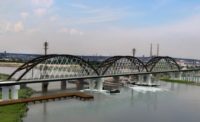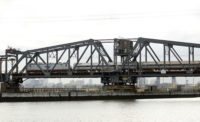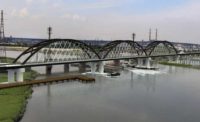New Jersey’s Portal Bridge, a 110-year-old structure long the bane of Northeast Corridor rail travelers, is a step closer to becoming a memory with NJ Transit’s award of a $1.6-billion replacement project contract to a joint venture of Skanska and Traylor Brothers. A joint venture of AECOM and STV will provide construction management services.
Approved unanimously on Oct. 12 by the transit agency’s board of directors, the project, to be called the Portal North Bridge, calls for replacing the problematic swing bridge with a two track, high level, fixed-span structure that will rise 50 ft above the Hackensack River, double the height of the existing bridge. This will allow marine traffic to pass underneath the structure, eliminating the need for periodic swing-bridge openings that frequently interrupted Amtrak and NJ Transit service along the corridor's most heavily trafficked section.
NJ Transit shortlisted four teams in May for what will be its largest-ever construction contract, with Skanksa/Traylor and the Tutor Perini/O&G Joint Venture subsequently invited to submit proposals. The other shortlisted teams were HS Constructors Joint Venture and Kiewit Infrastructure Co.
Expected to take five and one=half years to complete once construction gets underway in 2022, the Portal North Bridge project includes building retaining walls, deep foundations, concrete piers, structural steel bridge spans, rail systems, demolition of the existing bridge and related incidental works along a 2.44-mile corridor. The first track is set to be open in November 2025, with full completion in 2027.
Funding for the project will come from the NJ Transit, Amtrak and the U.S. Dept. of Transportation, including a $766.5-million Federal Transit Administration grant provided in January. About $811 million will come from New Jersey, $261.5 million from Amtrak and $57.1 million from the Federal Highway Administration.
The Portal North Bridge is considered part of the Gateway Program, which aims to double rail capacity between Newark and New York through the construction of two new Hudson River tunnels and rehabilitation of the existing century-old tubes.
The aging structure had also become increasingly susceptible to maintenance issues in recent years, compromising its reliability and ability to support the region’s growing demand for rail service. Prior to the COVID-19 pandemic, the bridge carried approximately 200,000 passengers a day on more than 450 Amtrak and NJ Transit trains. The new bridge will also support train speeds of up to 90 mph, a significant increase over the current 60 mph speed limit.





Post a comment to this article
Report Abusive Comment